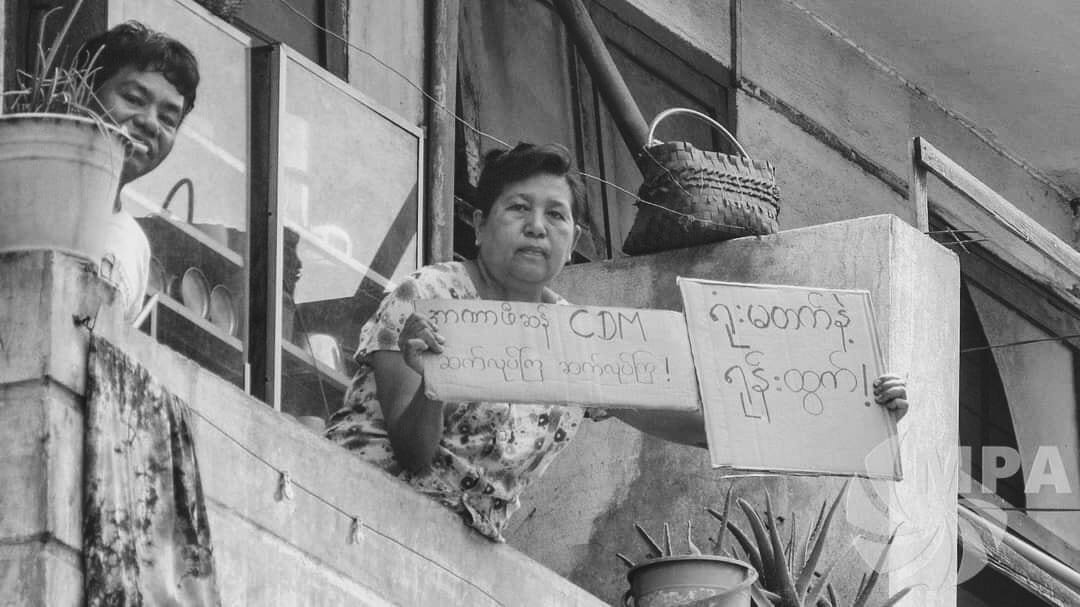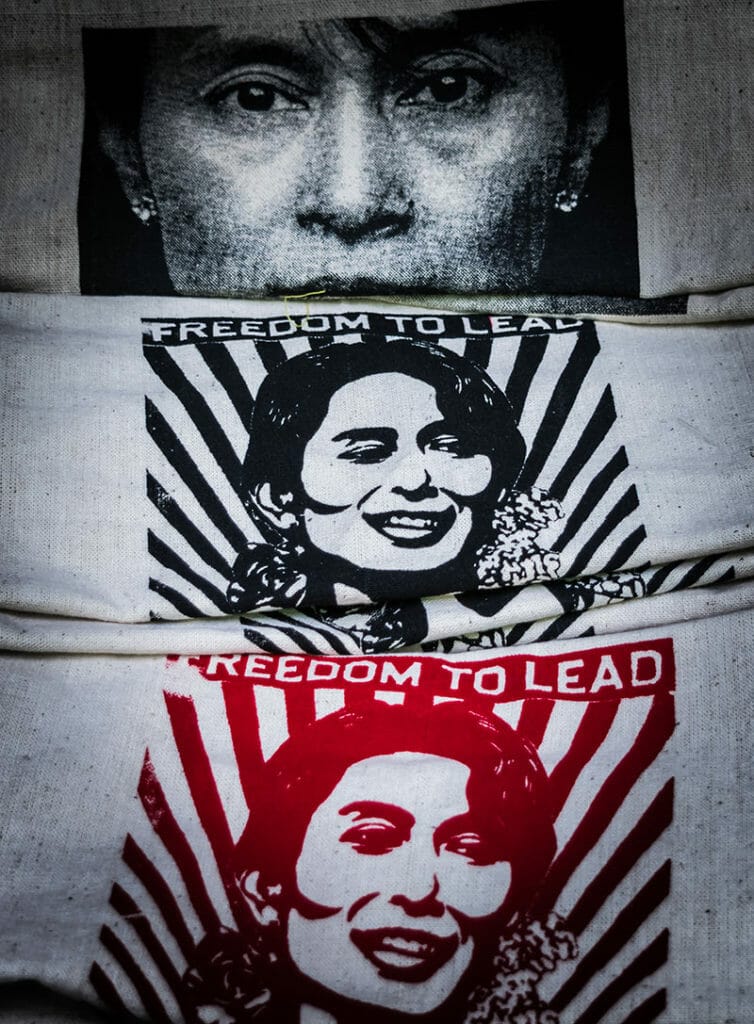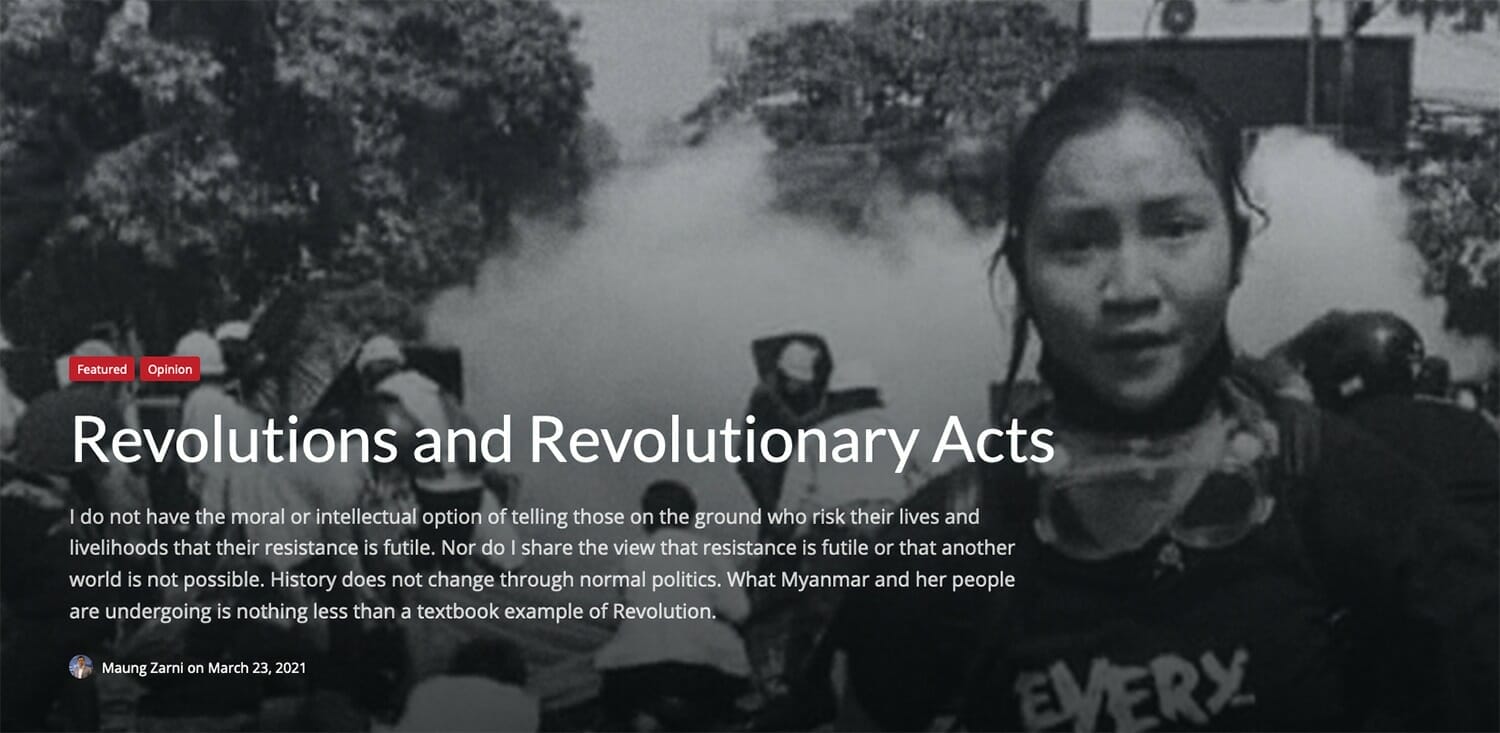Federal Army for Federal Democracy
Federalism, or more accurately the pursuit of a federalist power-sharing arrangement among the country’s diverse ethnic communities has been a perennial issue since Myanmar’s independence from Britain in 1948.
The call for the founding of the Federal Army – with its slogan Federal Army for Federal Democracy – is becoming progressively louder as the number of Myanmar activists and non-activist citizens – including nearly 4 dozen children, now over 600 deaths – have been murdered by the country’s Tatmadaw or the formerly national defence force since the 1 February 2021 coup.
Equally important, the renewed fighting between the terrorist troops and several major EAOs such as the Kachin Independence Army, the Karen National Liberation Army Brigade 5, the RCSS have caused a sharp rise in war-fleeing refugees, including Myanmar police officers, into the neighbouring Indian states of Mizoram and Manipura as well as Thailand. In Northern and Eastern Myanmar, there are thousands of ethnic Kachin, Shan and Karen war refugees and internally displaced persons (IDPs). The largest among them are Karen refugees – estimated 20,000 – who have fled their villages as Myanmar terrorists launched relentless attacks from the air as well as the ground. They remain in dire humanitarian situations along the Thai-Myanmar borders.
The voices calling for inter-ethnic unity as the basis for forming an armed force capable of protecting civilian populations, protesters and all civilian populations alike, and their self-proclaimed right to self-defence are being reported favourably in the international media.
This call is loudest among the overwhelming majority of the dominant ethnic Bama or Burmese who make up 60-70% of the total population of 54 million who feel they are the only ethnic group that has no armed organization that can protect them from the continuing terroristic assault by their once national military. The Burmese public now want a new multi-ethnic military, drawing strength, expertise and support from the nearly 2-dozen ethnic armed organizations or EAOs.
Perhaps belatedly, Myanmar’s ethnic majoritarian public offer open apologies for their past indifference to the pains and repression which the national minorities have suffered, including Rohingyas. Their apologies are part sincere and part pragmatic: they look to any and all minority armed organizations for practical help, sanctuary, training and support for building a force that could protect them from daily and nightly terror living in the country under siege by State Administrative Council, the coup regime.
A large segment of state employees has succeeded in denying the coup regime a functioning state/administration. Almost daily protests have rendered the national economy completely non-functioning. Former government troops roam the streets of towns and cities, terrorising residents day and night, brazenly kidnapping activists and other citizens for ransom in broad day light.
As a result, several thousand Myanmar activists, drawn from all walks of life across cities and towns, are undergoing guerrilla training, in EAO-controlled war zones of the country in the anticipation of the looming civil war.

A family of civil servants holding the CDM placards. CDM has effectively denied Myanmar coup regime a functioning state, having crippled the latter’s ability to run vital sectors such as transportation, banking, accounting, civil administration and so on.
A Break with the Accommodationist Policies of the National League for Democracy and Aung San Suu Kyi
The coup regime’s Nazi-like repression and daily and nightly sadistic violence by rank and file security troops against the anti-coup protesters, has triggered a radical shift in popular consciousness regarding the Tatmadaw or the government’s military, and turned virtually all segments of Myanmar against it.
Consequently, the nationwide protests have moved their goal posts, from the release of detained leaders, recognition of their nullified results of the elections held within the framework of the military’s 2008 Constitution to a set of decidedly revolutionary goals. Protest leaders and their supporters now aim at abolishing the 2008 Constitution designed specifically to keep the military above the democratic process and perpetuate its commanding position in society and economy; the dismantling of the Tatmadaw – not just removing the coup regime – and, in its place, installing a Federal Army befitting a popularly revived vision of a Federal Democratic Union.
To its credit – and in a radical departure from Ms Suu Kyi’s policy of amending the Constitution and working within the military-guided “disciplined flourishing democracy”, the Committee Representing Phyidaungsu Hluttaw (or National Parliament), Myanmar’s parallel government made up of a group of largely NLD MP-elects, has declared the abolition of the anti-democratic 2008 Constitution as of April, 2021. Symbolically, protesters across Myanmar and those of us in the diaspora or in exile had burned the green covers of the document.
Dr Sasa, a medical doctor and humanitarian, who now serves as the CRPH’s envoy to the UN told Canada’s leading paper Globe and Mail, “This (anti-coup movement) is not about the NLD anymore. This is about all the people of Myanmar. We are talking to as many ethnic parties across the country, and civil society organizations, as we can.”
For in the eyes of the country’s public, both the ethnic majority and national minorities, the formerly patriotic – patriotic to the Burmese majority at least – the military has morphed into “nothing more than armed gang of terrorists”, as dubbed by the Strategic Advisory Council for Myanmar (SAC-M) set up as a support platform by former UN human rights investigators in response to the February 1, 2021 coup.
In the thousands of videoclips and Facebook Live videos which have flooded social media platforms since the bloody crack-down began 2 months ago, the military and its associated security troops including snipers and commandos have been seen murdering unarmed, peaceful civilian protesters in towns, cities and villages across Myanmar. In my two hour-long public conversations with the two frontline leaders of the protest movement – Ei Thinzar Maung in Yangon and Wai Moe Naing in Monywa – both stressed the extremely sadistic nature of terror, torture and violence amply on display as the troops engage in all manners of merciless violence.
The apparent sadism and the blanket of impunity these troops enjoy is what has irreversibly radicalized the popular opinion against the once-venerable institution set up as an instrument of national liberation for the majority ethnic Burmese from British colonial rule.
“The Tatmadaw [the official name for the Myanmar army] is waging war against its own people – they have shown their true colours: they are the terrorists,” Yawd Serk, Thailand-based chairman of the Restoration Council for Shan State (RCSS) of Myanmar, was quoted as saying to the Bangkok Post.
To be sure, the emerging consensus on the essential need to defeat, dismantle and replace the China-backed Burmese military as the world’s first terrorist network with an air force and a navy is revolutionary and unprecedented. However, building a federalist democracy remains an elusive issue, even at the level of conceptualization and political deliberation because of economic, territorial and institutional interests of ethnic armed organizations.
The New Politics of Federalist Democracy and the Baggage of Aung San Suu Kyi
Three types of ethnic armed organizations are present throughout the swarths of vast boundary regions which border with China, India, Thailand, and Laos. Among them are the 10-member Nationwide Ceasefire Signers, and the non-NCA signers made up of the 3 Brotherhood Alliance of the Arakan Army, Ta’ang National Liberation Army and Myanmar National Democratic Army, and two additional and most powerful groups, namely Kachin Independence Army and the United War State Army.
With the exception of UWSA, widely seen as China’s proxy inside Myanmar, the rest of the armed organisations publicly stand with the anti-coup and anti-Tatmadaw protest movement in the formerly central-state-controlled towns, cities and villages.
If the last 70-years offer any proof, in an ethnically diverse country such as Myanmar, the workings of the ethnic majoritarian democracy, without full-appreciation and embrace of the need for a federalist state, have proven woefully inadequate at best and the greatest barrier at worst in building and developing the country into a peaceful modern nation-state.
Immediately following the end of WWII, the multi-ethnic and multi-class group of nation-builders led by the Marxist-inspired revolutionary leader Aung San conceived a new and independent Burma – Myanmar since 1989 – as a new political state which was to be democratic in its political workings, federal in structure, and voluntary inter-ethnic union in spirit.
With the benefit of hindsight, the founders’ dream of building a union out of ethnic and religious diversity became the Archilles’ heel.
Subsequent to the assassination of the group of pioneering federalists of pre-independence Burma including Ms Suu Kyi’s father U Aung San, both Burmese politicians, the 3-generations of Burmese politicians including the late Prime Minister U Nu (in office, 1948-1962 with the 18-month interval), the NLD leader Ms Suu Kyi and the ethnically Burmese military leaders have deceived and/or mistreated, politically, culturally and militarily, ethnic minority communities as second-class ethnicities.
Some among the Burmese public may object to the mention of the revered NLD leader and the reviled generals in the same breath. But their mistrust of Burmese politicians, public and the military leaders is genuine and justified. Her 5-years in office as the State Counsellor, Ms Suu Kyi crushed the minorities’ hope for a more empathic, less-majoritarian politics and conversely more sensitivity to devolution of state power.
Her martyred father Aung San succeeded in winning over the reluctant representatives of non-dominant ethnic communities such as Kachin, Shan, Chin who gathered at the first Panglong Conferences of 1946 and 1947 and produced the founding treaty for the soon-to-be independent state of Burma, with the guaranteed group right to self-determination, an emphasis on their voluntariness in joining the new post-colonial Union of Burma, and genuinely federalist power arrangements. Alas, Aung San remained the only Burmese political leader who transcended narrow-minded Bama racialism and political Buddhism since independence.
In sharp contrast, Ms Suu Kyi appeared to have sung from the same Burmese-chauvinist hymn sheet where the dominant Bama group are more equal than other national ethnic communities. Rightly, the non-Bama ethnic leaders and respective communities felt – and continue to feel – that both Suu Kyi and generals have continued with their internally colonialist policies and approach to the concerns of non-dominant ethnic communities.

An earlier picture of Aung San Suu Kyi on T-shirt at a market in Yangon, Myanmar. Photo: Toca Marine / Shutterstock.com
Additionally, Ms Suu Kyi had, with disastrous consequences for both the majority Burmese and the rest of the ethnic communities, prioritized her pursuit of pragmatic accommodation and reconciliation with her captors – the Burmese military leaders – while relegating the need to build solidarity and full collaboration with the non-Burmese, who make up 30-40 percent of the country’s total population.
The lowest point in Ms Suu Kyi’s leadership and policies was when in December 2019 when she travelled to the Hague in order to defend the charges of genocide against the country’s Muslim minority Rohingyas acting as the Agent of the effectively military-controlled Union of the Republic Myanmar at the International Court of Justice. Besides, she had officially praised in writing the Burmese military when it launched vicious military operations against Buddhist Rakhine minority group in Western Myanmar.
She also failed to heed the local ethnic communities’ calls for appointing popular non-Burmese and non-NLD ethnic representatives to key posts as provincial or regional governors. She thus missed a strategic opportunity to build bridges in regions where the military has acted as alien occupying force, committing all kinds of war crimes and crimes against humanity against the politically defiant and militarily organized ethnic communities.
It is this bitterly disappointing record of the policies of the NLD party and Ms Suu Kyi’s leadership that has made the non-Burmese ethnic groups, with their respective ethnic armed organizations, reluctant to instantly embrace the NLD-based CRPH’s talk of federal democracy.
In addition, these communities did not appreciate the NLD-focused manner in which CRPH continues to operate in their political dealings with non-NLD supporters.
From the perspective of Myanmar’s national minorities – especially ethnic armed organisations – the freshly-minted CRPH has, in haste, dumped on their laps its own version of “Federal Charter”, as a fait accompli, without due consultations and deliberations.
A sense of urgency felt by the CRPH leaders is understandable. However, the complex long-standing emotional and political issues which pervade non-Bama communities cannot be addressed in such a hasty manner.
It is therefore imperative for the CRPH to accept and appreciate the need to de-centre the NLD leader Aung San Suu Kyi and her failed policies towards national minorities or ethnic nationalities. The CRPH has done an admirable job of validating Rohingya identity, their right to belong as full and equal citizens of Myanmar and recognizing the genocidal nature of the persecution they have suffered at the hands of the Burmese military over the last several decades.
Now it needs to urgently undertake similar enlightened measures by issuing a formal acknowledgment of the international state crimes including war crimes and crimes against humanity towards other non-Bama ethnic communities such as Kachin, Shan, Chin, Rakhine, Karen, Mon, and so on, and kick-starting a genuinely deliberative process. The CRPH should use its Federal Charter – not as a completed new federal constitution – but as merely draft to be used as a basis for trust-building initiative and for seeking input from various minority stakeholders, most importantly ethnic armed organisations.
On matters military, the Ethnic Armed Organisations should be in the driver’s seat as they have decades of relevant experience – and the standing military units.
If the CRPH makes it clear to the reluctant communities of non-Bama ethnic peoples that it will no longer insist on putting Ms Suu Kyi at the centre of the new federalist politics as envisaged and desired universally in Myanmar, it will go a long away.
Realistically, Ms Suu Kyi will very unlikely have any political future as long as the Tatmadaw or the terrorist gang remains undefeated.
The Burmese military has long institutionalized the hostile and false view that federalism is a sure-fire formula for the country’s disintegration. Some 15 years ago, the current Defence Minister of the coup regime, General Mya Tun Oo, then a military intelligence colonel, expressed the “federalism as nation-disintegration” view in my conversation with him while the 2008 Constitution was being drafted at the Constitution Drafting Convention at Nyaung Na Pin. Over time his view – and that of the military – would only harden. Accordingly, the generals will do everything in their power – and have done so for more than half-century – to prevent the realization of the 7-decades-old founding federalist vision of Myanmar.
Ms Suu Kyi may be the most popular and popularly elected politician in the majoritarian democracy, but she can no longer be the leader of the entire country, especially when the minorities judge her a failure in ushering in a new federalist politics.
This is a bitter pill to swallow for those who have revered Ms Suu Kyi for her personal sacrifices and addressed her as “Mother” of the nation. I write these words as a Burmese whose activism was inspired by her early years in captivity. For 15 years I was a foot soldier for her policies and leadership.
But Myanmar peoples of all ethnic backgrounds are undergoing a revolutionary process. Ms Suu Kyi may have to be asked to make the ultimate sacrifice: give up her centre stage in order that a revolution can grow and succeed in its revolutionary mission of building both a federal army and federal democracy.
Or else the pursuit of federalism in Myanmar will continue to be the Achilles’ heel for all democrats and federalists, the majority and minorities.
Still there is reason for hope of a federal democracy. Sai Leik, the spokesperson for the Shan people’s largest political party Shan National League for Democracy exhorted, “at this time, the public spirit is at an all-time high. While the word ‘federal’ is widely accepted, we should start making efforts to have a federal army and a federal union. We should act bravely and decisively.”
Maung Zarni
Banner: Police crack down on anti-coup protesters in Yangon, Myanmar on 7 March 2021. Image: Maung Nyan / Shutterstock.com


